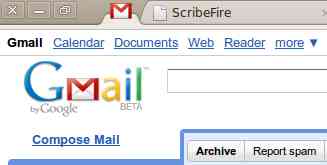Two days ago with a great deal of sadness, I took the final step – I set my default browser to Google Chrome.
After using Firefox for five years, I’ve been fighting it for a while now, but I could hold back no longer. With Chrome supporting Greasemonkey scripts, I was able to replace my beloved Firefox Ubiquity plugins including those which allowed me to quickly surround text with HTML tags for easy blog commenting among other tasks. So here are five reasons why I finally made the switch:
In Chrome, one tab doesn’t hang the others

Some sites like Slashdot contain lots of Javascript, CSS and Ajax. The same goes for Gmail. The problem with Firefox is that while these complex pages are loading, it freezes every other tab! It’s very irritating to have to wait seconds while a new Slashdot page opens up. You can’t switch, or type. And since I always open new tabs in the background, I want to be able to continue to do what I want in the meantime. Google Chrome on the other hand runs each tab in a separate process – so no matter how badly one tab misbehaves, the others don’t suffer. I can happily open a new Gmail window in the background and just continue to do what I’m doing until I’m ready to turn my attention to it. Chrome is also blazingly fast – pages are rendered in no time at all and applications just feels snappier.
I can reclaim the “status bar” space
I can’t stand stuff getting between me and the web. That includes bookmark bars, navigation bars, search bars, and finally the status bar. Until I tried Chrome, I never realized how I hated the status bar. To be sure, there are plugins or add ons for Firefox that remove the status bar, but in the first place I don’t like to install too many add ons and second, none of them exactly replicates the status bar behavior in Chrome – namely by:
- Not being present
- Showing up when I hover a link – some do, but they show the entire bar instead of just the URL
- Showing a shortened version of the link
- Expanding the URL if I hover a little longer
I’m a stickler for space and Chrome’s solution is so elegant and neat that it’s a wonder why other browsers haven’t just copied it outright.
Chrome’s new Web Applications are awesome
One of Chrome 6’s new features is the ability to make web applications. I use some sites like Gmail a lot and would like to keep them open all the time. So by making it a web application, I can have it minimize the space the tab uses, have it open all the while, and also remove the navigation bar, search bar, etc for that app! Here’s what it looks like:

Ain’t that awesome? I need never close Gmail again. It’s always on the left, can’t be moved, doesn’t interfere with my regular work and allows me to access it at a moment’s notice. I’m told that Firefox 4 is coming out with something of the sort in it’s later Beta versions.
Chrome’s Bookmark Sync
Using a simple Google sign in, I can now synchronize my bookmarks across all Chrome browsers no matter which computer I’m using. One of the motivations for moving to the cloud by using Google Docs and Gmail is so that I have complete flexibility and don’t need to be tied down to any single piece of hardware. Chrome’s bookmark sync also allows me to synchronize my extensions, preferences and themes.
Firefox tried to integrate such a feature earlier and called it “Weave”, but they never got the implementation right – it was buggy, and slow. Google’s got this one down pat. It’s completely seamless and doesn’t necessitate any additional sign ins. Marvelous!
Greasemonkey Integration
Greasemonkey is a simple tool that allows users to do cool stuff with their browsers. For example, if you want to comment on a blog and need to italicize some text, you have to wrap it in “<em></em>” tags. To make it bold, you have to surround the text with “<strong></strong>.” I find this painful. While using Firefox, I wrote a Ubiquity script that would save me from this painful typing. But Google Chrome didn’t have Ubiquity and till now, this was the one thing holding me back from adopting Chrome full time.
But when I found out that Chrome now natively supported Greasemonkey scripts which till now only worked on Firefox, I went and found one that did the same job! True, I had to tweak it before it worked in Chrome, but now if I want to italicize a comment, I just press “Ctrl+I” and if I want to insert a hyperlink, I just press “Ctrl+Shift+M” and the <a> tag is fully formed with the cursor in the right place to paste the URL!
This was the feature that finally tipped me over. And so now I’m officially a Google Chrome user instead of a Firefox user.
Another thing that nudged me over was the fact that Firefox 4’s latest Beta for Linux didn’t have the new look which the Windows version got. I was pissed I and felt I wasn’t being treated on an equal footing. But I’ve used Firefox for so many years now that I won’t hold a grudge. I’m willing to be lured back to Firefox if they improve their speed to a level comparable to Chrome’s. But for now, I bid Firefox good bye and with tears in my eyes, save this post in my shiny new Google Chrome browser…
http://sites.google.com/a/chromium.org/dev/gettin… thats the link to the site for developers
In reply to Dhruva Mathur
No – I mean a link to where it says that the latest Chrome is 30 times faster than the previous release.
I'm asking because I follow the speed tests pretty closely and though I know Chrome is fast, I don't think it's that fast!
http://chrome.blogspot.com/2009/08/new-beta-why-s… it is, if you consider V8
In reply to Dhruva Mathur
Ah – 30 percent faster. That makes more sense!
I had got confused because you mentioned that it was 30 times faster :) Must have been a typo…
oh lol yeah 30% :D
The new google chrome 6.0.472.25 dev, sleeker omnibox, faster, autofill function n a lot more
In reply to Dhruva Mathur
Actually I noticed that the size of the omnibox has increased a bit compared to previous versions – but I’m running Linux so Windows users may not see the same thing…
k. bt in windows d size has reduced drastically. I guess I LUV GOOGLE CHROME
In reply to Dhruva Mathur
It really is pretty cool. I wonder why Google’s trying to mess with net neutrality with the recent memo with Verizon though :(